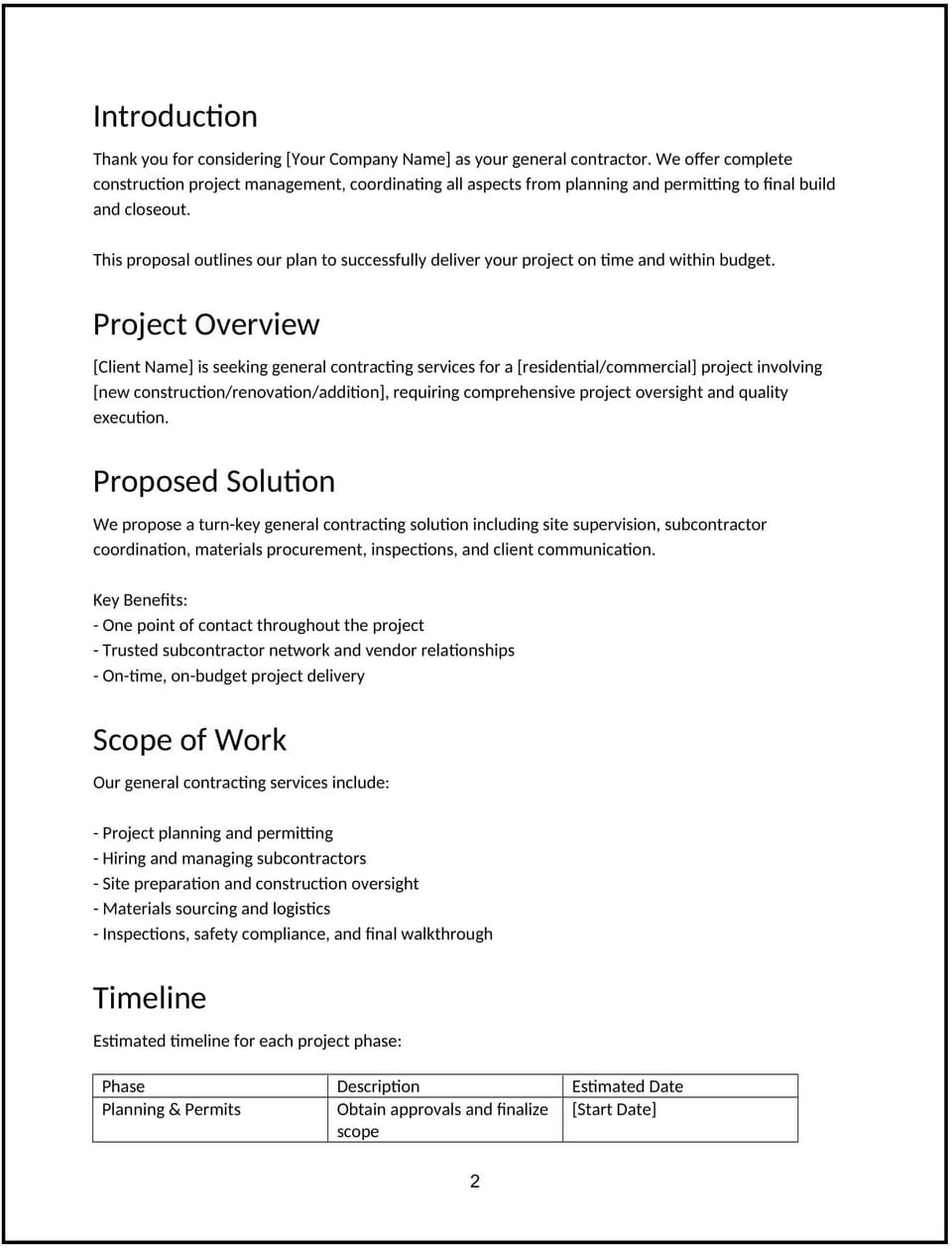General contractor proposal: Free template

Customize this free general contractor proposal with Cobrief
Open this free general contractor proposal in Cobrief and start editing it instantly using AI. You can adjust the tone, structure, and content based on the project scope, client requirements, and type of build. You can also use AI to review your draft — spot gaps, tighten language, and improve clarity before sending.
Once you're done, send, download, or save the proposal in one click — no formatting or setup required.
This template is fully customizable and built for real-world use — ideal for home remodels, commercial fit-outs, additions, or new construction. Whether you’re responding to an RFP or submitting a quote after a site walkthrough, this version gives you a structured head start and removes the guesswork.
What is a general contractor proposal?
A general contractor proposal outlines the full scope, timeline, and pricing for managing a construction or renovation project. It’s typically shared after a site visit, consultation, or architectural review, and helps the client understand how the project will be executed — from permits and labor to materials and subcontractor coordination.
A strong proposal gives the client confidence in your ability to deliver the job on time and on budget.
A general contractor proposal helps:
- Define all services included — from demo to finish
- Set clear expectations around budget, phases, and timelines
- Communicate professionalism and planning
- Provide a clear path to project approval
If you’re managing builds and want to turn a verbal discussion into a confirmed job, this proposal format is the next step.
Why use Cobrief to edit your proposal
Instead of formatting a doc manually or copying an old quote, use Cobrief to create and polish a professional proposal in minutes — with built-in AI support.
- Edit the proposal directly in your browser: Just click and customize — no setup required
- Rewrite sections with AI: Expand, clarify, or simplify technical descriptions to match the client’s expectations
- Run a one-click AI review: Spot vague language or gaps in scope before sending
- Apply AI suggestions instantly: Accept edits one-by-one or apply all in a single click
- Share or export instantly: Send a live link or download a clean PDF or DOCX version with your branding
Cobrief helps you present construction projects clearly — and professionally.
When to use this proposal
This general contractor proposal works well for:
- Quoting residential remodels, additions, or new builds
- Proposing commercial or office renovations
- Submitting formal bids for RFPs or public contracts
- Presenting phased project plans to investors or developers
- Following up after architectural drawings or walkthroughs
Use this when you want to win the job and show clients you’re ready to manage the full build.
What to include in a general contractor proposal
Each section of this proposal is designed to guide the client through your plan clearly and confidently. Here's how to use them:
- Executive summary: Recap the client’s goal and your proposed solution (e.g., “Manage the full renovation of a two-story retail space, including demolition, MEP upgrades, drywall, and finish work.”)
- Scope of work: List everything included — demo, framing, electrical, plumbing, HVAC, windows, finishes, inspections, etc. Be detailed and precise.
- Project timeline: Break the project into phases with estimated start and completion dates. Include key milestones and inspection windows.
- Subcontractors and vendors: Mention if you’ll be managing licensed trades (e.g., electricians, plumbers), and how coordination will be handled.
- Permits and compliance: Clarify who’s responsible for pulling permits, meeting local codes, and scheduling inspections.
- Materials and equipment: Note whether materials are client-supplied or included. List key fixtures, systems, or finishes if relevant.
- Pricing: Provide a clear breakdown — by phase, trade, or room. Include labor, materials, equipment, and contingencies if needed.
- Terms and conditions: Cover payment schedule, change orders, site access, cleanup, and warranty. Use plain English.
- Next steps: End with a clear CTA — e.g., “Reply to confirm and schedule the site prep,” or “Click to approve and we’ll prepare the contract.”
How to write an effective general contractor proposal
Clients care about quality, timelines, and cost control. Use these tips to make your proposal stronger:
- Be specific and structured: Avoid vague descriptions — define each stage of the job
- Break down costs transparently: Clients want to know what they’re paying for and why
- Set realistic timelines: Build in time for weather, inspections, or material lead times
- Mention oversight and coordination: Show how you’ll manage trades and keep things moving
- Flag exclusions or allowances: Clarify what’s not included (e.g., landscaping, appliances)
- Close with confidence: Make it easy for the client to say yes and move forward
Frequently asked questions (FAQs)
Can I include multiple quote options or tiers?
Yes — you can list good/better/best options or phased approaches based on budget or material preferences.
Does this proposal include permit handling?
If you’re managing permits, include that in the scope. If not, clearly state it’s the client’s responsibility.
Can I include a payment schedule or draw plan?
Absolutely — break down payments by milestones (e.g., deposit, framing, rough-in, completion).
Can I add design collaboration or sourcing services?
Yes — just include those in the scope and adjust pricing accordingly.
Is this proposal a contract?
No — this is a proposal. You can attach or link a formal construction agreement separately.
This article contains general legal information and does not contain legal advice. Cobrief is not a law firm or a substitute for an attorney or law firm. The law is complex and changes often. For legal advice, please ask a lawyer.